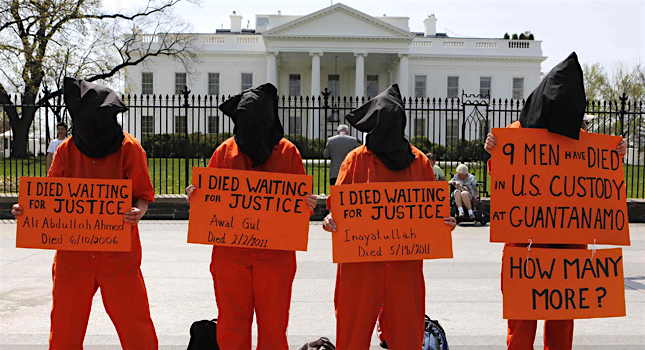Another Sad, Forgotten Anniversary for Guantánamo’s Dead
Please support my work! I’m currently trying to raise $2500 (£2000) to support my writing and campaigning on Guantánamo and related issues over the next three months of the Trump administration.
Today, June 10, is an important date in the Guantánamo calendar — the 11th anniversary of the deaths, in dubious circumstances, of three men at Guantánamo in 2006: Yasser al-Zahrani, a Saudi who was just 17 when he was seized in Afghanistan in December 2001, Mani al-Utaybi, another Saudi, and Ali al-Salami, a Yemeni.
According to the US authorities, the three men committed suicide, hanging themselves in their cells, after having stuffed rags down their own throats, but that explanation has never seemed convincing to anyone who has given it any kind of scrutiny. Even accepting that the guards were not paying attention, how did they manage to tie themselves up and stuff rags down their own throats?
An official investigation by the NCIS yielded an inadequate statement defending the official narrative in August 2008, and then, in January 2010, an article in Harper’s Magazine by Scott Horton presented the US authorities with a powerful critic of the official suicide narrative, Staff Sgt. Joe Hickman, who was in charge of the guards in the towers overlooking the prison. On the night of June 9, 2006, just before the deaths were acknowledged, Hickman had noticed unusual movements by vehicles traveling to and from the prison, in the direction of a secret facility he and his colleagues identified as “Camp No,” where, he presumed, they had been killed — whether deliberately or not — during torture sessions. Read the rest of this entry »
Death at Guantánamo: Psychologist and Author Jeffrey Kaye Speaks to the Talking Dog
 Please support my work! I’m currently trying to raise $2500 (£2000) to support my writing and campaigning on Guantánamo and related issues over the next three months of the Trump administration.
Please support my work! I’m currently trying to raise $2500 (£2000) to support my writing and campaigning on Guantánamo and related issues over the next three months of the Trump administration.
In my eleven years of researching, writing about and campaigning to close the US prison at Guantánamo, I have got to know some remarkable people — from lawyers and former prisoners to individuals who, often for little or no financial reward, have devoted considerable time to covering important aspects of the Guantánamo story that others — often in the mainstream media — have missed or ignored. Some of my supporters would put me in the category of those covering important aspects of the story for little or no reward, and I’m grateful to those who recognize this, but I’m pleased, today, to be able to promote the work of two other people I admire a great deal who also fit this category of truth-seeker — the New York-based blogger The Talking Dog, and the San Francisco-based psychologist Jeffrey Kaye, who was interviewed by the Talking Dog by email just a few weeks ago, for an interview first published here, and cross-posted below.
For over ten years now, The Talking Dog has been interviewing lawyers, former prisoners, former guards, journalists and other involved in the Guantánamo story, and over 70 interviews are posted and linked to at the end of this article, which are essential reading for anyone researching, writing about or just interested in Guantánamo. TD interviewed me back in the summer of 2007, just before my book The Guantánamo Files was published, and we have been friends ever since.
Jeff and I have also known each other for many years, meeting for the first time at Berkeley Says No to Torture Week (in October 2010), which was my third visit to the US, and then again in January 2012, and again in January 2014, and I have long taken an interest in his work, cross-posting articles of his in 2011 and 2012 — see The Time is Right for Americans to Pay Attention to Human Rights Watch’s New Torture Report, New Revelations About The Use of Water Torture at Guantánamo, More Evidence of the Use of Water Torture at Guantánamo and in Afghanistan and Iraq, and also two articles written with Jason Leopold, US Training Manual Used As Basis for Bush’s Torture Program Is Released by Pentagon and Pentagon Report into the Drugging of Guantánamo Prisoners Is Released, and, of particular relevance right now, Were Two Prisoners Killed at Guantánamo in 2007 and 2009? Read the rest of this entry »
Libyan Who Abandoned Habeas Corpus Petition, Citing Its “Futility,” Asks Review Board to Approve His Release from Guantánamo
 Last week, a Libyan prisoner at Guantánamo, Ismail Ali Faraj al-Bakush (aka Ismael al-Bakush), who is 48 years old, became the 53rd prisoner to face a Periodic Review Board. The PRBs were set up in 2003 to review the cases of prisoners who had not already been approved for release, or were not facing trials, and to date 29 men have been approved for release, while 13 have had their ongoing imprisonment upheld.
Last week, a Libyan prisoner at Guantánamo, Ismail Ali Faraj al-Bakush (aka Ismael al-Bakush), who is 48 years old, became the 53rd prisoner to face a Periodic Review Board. The PRBs were set up in 2003 to review the cases of prisoners who had not already been approved for release, or were not facing trials, and to date 29 men have been approved for release, while 13 have had their ongoing imprisonment upheld.
This is a 69% success rate for the prisoners, which is remarkable — and remarkably damaging for the credibility of the Obama administration — because the majority of these men were described, by the high-level, inter-agency Guantánamo Review Task Force that President Obama set up shortly after taking office in January 2009, as “too dangerous to release,” when the reality has not borne out that caution. Others were recommended for prosecution, until the basis for prosecutions in Guantánamo’s military commission trial system largely collapsed after a series of devastating appeals court rulings, confirming that the war crimes being tried were illegitimate, having been invented by Congress.
Ismail al-Bakush is one of 41 men eligible for the PRBs who was initially regarded as “too dangerous to release,” even though the task force acknowledged that insufficient evidence existed against any of these men to put them on trial. 23 others were initially recommended for prosecution, and just eleven men are still awaiting reviews, while 12 others (including al-Bakush) are awaiting the results of their reviews. See my definitive Periodic Review Board list on the Close Guantánamo website for further information. Read the rest of this entry »
Remembering Guantánamo’s Dead
 Every year, I publish an article remembering the men who died at Guantánamo in what, in 2013, I first described as “the season of death” at the prison — the end of May and the start of June, when six men died: three on June 9, 2006, one on May 30, 2007, another on June 1, 2009, and the last on May 22, 2011.
Every year, I publish an article remembering the men who died at Guantánamo in what, in 2013, I first described as “the season of death” at the prison — the end of May and the start of June, when six men died: three on June 9, 2006, one on May 30, 2007, another on June 1, 2009, and the last on May 22, 2011.
Of the six, only the last death — of Hajji Nassim, an Afghan known in Guantánamo as Inayatullah — appears very clearly to have been a suicide. Nassim had profound mental health issues (as well as being a case of mistaken identity), but although there was no reason to suspect foul play, it is, as I explained last year, “disturbing and disgraceful that a profoundly troubled man, who was not who the authorities pretended he was, died instead of being released.”
Doubts have also been raised about the deaths in 2007 and 2009, as I also explained last year, when I wrote:
My very first articles, in May/June 2007, were written in response to the alleged death by suicide, on May 30, 2007, of a Saudi prisoner, Abdul Rahman al-Amri. Former prisoner Omar Deghayes later told me that al-Amri had been profoundly upset by the sexual harassment at Guantánamo — enough, perhaps, to lead him to take his own life — but Jeff Kaye (psychologist and journalist) later looked into the investigation into his death and found another murky story, as he did for Muhammad Salih (aka Mohammed al-Hanashi), another long-term hunger striker and agitator who died on June 1, 2009.
Former Guantánamo Military Defense Attorney Todd Pierce Interviewed by the Talking Dog
 I’m delighted to be cross-posting below an interview conducted by my good friend The Talking Dog (functioning below the radar under a pseudonym in New York City) with another good friend, Army Maj. Todd Pierce (retired), who, as a Judge Advocate General (JAG) officer, was part of the defense team for two Guantánamo prisoners charged in the military commissions — Ali Hamza al-Bahlul (still held) and Ibrahim al-Qosi (released in 2012).
I’m delighted to be cross-posting below an interview conducted by my good friend The Talking Dog (functioning below the radar under a pseudonym in New York City) with another good friend, Army Maj. Todd Pierce (retired), who, as a Judge Advocate General (JAG) officer, was part of the defense team for two Guantánamo prisoners charged in the military commissions — Ali Hamza al-Bahlul (still held) and Ibrahim al-Qosi (released in 2012).
Todd became fascinated by the philosophical origins of the Bush-Cheney military commissions in the Nazi era, and efforts to justify the commissions through a warped interpretation of US Civil War precedents. Since retiring, he has continued to pursue these interests, and has also become part of Sam Adams Associates, who describe themselves as “a movement of former CIA colleagues of former intelligence analyst Sam Adams, together with others who hold up his example as a model for those in intelligence who would aspire to the courage to speak truth to power,” and who, every year since 2002, have presented the Sam Adams Associates Award for Integrity in Intelligence to whistleblowers — most recently to Chelsea Manning, at an event in Oxford that I attended in February.
I do hope you have time to read the interview — which also includes Todd’s latest thoughts on the case of Ali Hamza al-Bahlul, who has been successfully appealing against his 2008 conviction and life sentence — with profound repercussions for the entire military commissions project, which, it should be noted, should never have been revived by George W. Bush and Dick Cheney in the first place.
If you enjoy it, please share it, and please also follow the links I’m posting at the end of this article to the Talking Dog’s extensive archive of interviews about Guantánamo and the “war on terror.” Read the rest of this entry »
“It’s Going to End in Men Dying”: Carlos Warner, Guantánamo Attorney, Discusses the Hunger Strike
 As the hunger strike continues to rage at Guantánamo, with at least 130 of the remaining 166 prisoners involved, I’m delighted to have the opportunity to cross-post an interview with Carlos Warner, an attorney with the Office of the Federal Defender for the Northern District of Ohio, who represents ten prisoners at Guantánamo — including a number of Yemeni prisoners, a “high-value detainee,” one of the last five Tunisians in Guantánamo, the only Kenyan, and Fayiz al-Kandari, one of the last two Kuwaitis in the prison.
As the hunger strike continues to rage at Guantánamo, with at least 130 of the remaining 166 prisoners involved, I’m delighted to have the opportunity to cross-post an interview with Carlos Warner, an attorney with the Office of the Federal Defender for the Northern District of Ohio, who represents ten prisoners at Guantánamo — including a number of Yemeni prisoners, a “high-value detainee,” one of the last five Tunisians in Guantánamo, the only Kenyan, and Fayiz al-Kandari, one of the last two Kuwaitis in the prison.
The interview was conducted by my friend The Talking Dog, a New-York based independent journalist who has conducted dozens of interviews with lawyers, journalists and former prisoners over the last eight years — which someone should publish as a book, at some point!
I am enormously grateful to The Talking Dog for putting me up on my generally annual visits to New York to campaign for the closure of Guantánamo, which began as a result of the friendship that we struck up after he interviewed me, back in September 2007, just as my book The Guantánamo Files was being published, and I hope you have time to read and publicize this interview. The hunger strike began because of aggression by the guards and the perceived abuse of the prisoners’ Korans, but as time has gone on, it has become a sustained protest against the men’s indefinite detention, and the fact that, having been abandoned by President Obama, they may die at the prison, even though 86 of them were cleared for release by the interagency Guantánamo Review Task Force that President Obama established just after taking office in 2009.













 Who's still at Guantánamo?
Who's still at Guantánamo?
